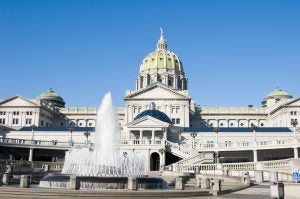Pennsylvania has an opportunity to lead on methane as EPA falters
 Last week, the Environmental Protection Agency held a public hearing on its proposal to gut key regulations that reduce climate-damaging methane emissions, and protect communities from pollution from oil and gas development. Methane, an extremely potent greenhouse gas responsible for 25% of current global warming, is also the main component of natural gas, which is an important energy resource in Pennsylvania.
Last week, the Environmental Protection Agency held a public hearing on its proposal to gut key regulations that reduce climate-damaging methane emissions, and protect communities from pollution from oil and gas development. Methane, an extremely potent greenhouse gas responsible for 25% of current global warming, is also the main component of natural gas, which is an important energy resource in Pennsylvania.
Pennsylvania is the second-largest natural gas producing state in the U.S. and should act now to ensure its residents do not lose key protections put in jeopardy by the federal government. Gov. Wolf recently committed to join the ranks of states working to limit carbon pollution. By joining the many other oil and gas producing states across the country stepping up to cut methane pollution from existing oil and gas infrastructure, Pennsylvania has a chance to lead by quickly advancing their current rule proposal.
Pennsylvanians are already witnessing firsthand the impacts of climate change, from more frequent, severe flooding that threatens the state’s agricultural sector, to more powerful heat waves that put lives at risk. That’s why Gov. Wolf’s pledge to cut emissions 80% by 2050, and his commitment to curb power-sector carbon pollution, are so important. However, comprehensive methane pollution regulation is a key part of making sure Pennsylvania can meet Gov. Wolf’s goals.
Gov. Wolf has recently committed to advance critical rules to the Environmental Quality Board by the end of 2019. This proposal to cut methane emissions from the vast amount of existing oil and gas infrastructure across the state is a necessary step to meet his goals, and also to better protect the over one million residents who live near oil and gas operations across the state.
Cutting methane emissions from oil and gas infrastructure is one of the most cost-effective ways to act on climate. The International Energy Agency estimates approximately half of global methane emissions can be cut at no net cost, and states like Colorado have seen that strong methane rules can go hand-in-hand with a thriving energy economy.
Pennsylvania has an opportunity to lead on methane as EPA falters Share on XIn 2018, Gov. Wolf and the Department of Environmental Protection finalized permits requiring methane controls at new and modified natural gas infrastructure, but new source-only controls do nothing to reduce most of Pennsylvania’s methane emissions, which come from existing oil and gas infrastructure.
EDF estimates that Pennsylvania natural gas operators emit over five times more methane than they report to DEP — about 500,000 metric tons — which has a climate impact bigger than all the cars in Pennsylvania. Absent quick action, that number could increase to five million tons by 2025. Because methane is the main component of natural gas and a saleable product, those emissions also mean millions in lost revenue. Continued action from Gov. Wolf will curb emissions and allow Pennsylvania to retain its growing methane mitigation industry, which brings well-paying jobs and economic opportunity to the state.
While EDF supports moving Gov. Wolf’s proposed existing source regulation to the EQB, there are several necessary changes that need to be considered:
- Removal of the threshold for low-producing wells.
- Removal of the leak-detection-and-repair (LDAR) step-down provision.
- Addition of methane as a pollutant directly regulated by the new rules.
Amid the rollback of the EPA’s federal methane standards, Pennsylvania has the opportunity to show the nation what responsible, commonsense leadership looks like. Meaningful climate action is something voters across the state have voiced support for, and the data are clear that comprehensive methane rules will deliver powerful benefits to communities throughout Pennsylvania.










